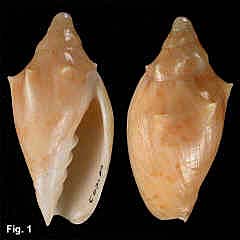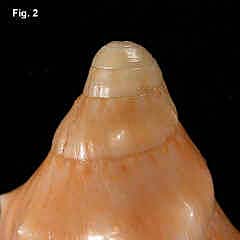|
|
|
|
|
Pseudocymbiola provocationis McMichael, 1961 Description: Shell solid, smooth and glossy. Protoconch 2 ½ whorls, with faint spiral striations, axial ribs absent. Spire moderately tall, concave. Whorls shouldered, concave above shoulder, convex below; shoulder with upwardly pointing spines, 5-7 on body whorl. Columella with four strong plaits. Outer lip simple, smooth. Colour (of holotype) yellow-fawn, with very faint, indistinct darker spiral bands below shoulder, at midbody and base; band of axial lines descending from suture faint, not continuous. Size: Holotype 45 mm Distribution: Holotype off Ulladulla, NSW; paratype off Port Kembla, NSW; Cape Hicks, Victoria. Habitat: Holotype and paratype trawled, depth unknown. Cape Hicks specimen 130 m. Remarks: This taxon is known from only three specimens; the holotype, paratype, and a third specimen reported by Bail & Limpus (1998). It has been suggested that it could represent of an extinct taxon. On describing the species, McMichael erected the genus Pseudocymbiola for it, on the basis of the large, smooth protoconch. Weaver & duPont (1970) treated it as a synonym of Cymbiola complexa, stating that "the protoconch of this deep water species is smooth because the radial ribs are covered by a glaze". Darragh (1989, p. 260) agreed with this assertion. Poppe & Goto (1992, p. 175) treated C. complexa as a form of C. pulchra, and treated provocationis as another form of Cymbiola pulchra, while recognising the differences "larger and more rounded apex, smaller size, fewer nodules on the shoulder and a more orange coloured shell". Bail and Limpus (1998), while recognising these same differences, preferred to use the original name assigned by McMichael. The holotype is illustrated in Fig. 1. The protoconch is shown in Fig. 2; faint spiral sculpture is evident, with no sign of glaze covering axial ribs. Fig. 1 HOLOTYPE. Off Ulladulla, NSW (C.063182) Fig. 2 Protoconch of holotype (C.063182)
|

